Hi,
here some data to show magnitude of effects room has on bass response, and how much bass box alignment matters in comparison.
Short story: I've had some 15" woofers for many years and have been prototyping a speaker system with three way mains speaker equal amount of time. Currently on third bass box version for the mains, and I've been downsizing every time as I've always had to EQ the lows lows down to match up sensitivity of rest of the system. Also, I've felt there is coloration of sound from the bass box, which ought to reduce by better construct, smaller panels, modes inside higher up in frequency, minding about the port and so on. In general, as box gets smaller any issues get higher up in frequency, hopefully beyond pass band and out of harms way and should reduce any "box sound".
But that would compromise the bass, right, making box smaller than a simulator suggests? True if only looking anechoic response on the screen and forgetting the box will be in a room along with rest of the stereo playback system. And in this case, a 15" bass provides plenty enough for my home use, so there is extra SPL potential that can be sacrificed. Your system and context might differ, so please post if you have an example, perhaps even a counter example.
Anyway, my first box is already scrapped so approximating a bit. I remembered it was 150l but it was likely smaller as simulator suggests 113l for the driver automatically. Lets assume it was 113litre and try to remember the tuning. Second box was and still exists about 80l. Third box is sealed and only about 50l. Here are box simulator responses for the three, all using the same woofer:
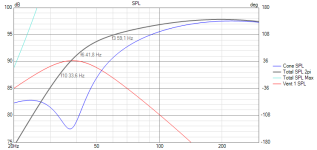
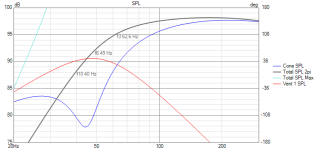
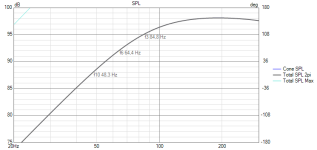
Dramatic difference, right, the 50litre box response drops much higher than the other two and should have underwhelming bass. Also the 80litre box should shame on the 113litre, which should have much "better" bass, right, that's what the simulator automatically suggests at least.
Let's find out, here is measurement of one of the boxes. This is box that does sub woofer duty right now, and one of the three above. Mic was at listening spot, ungated sine sweep. Can you guess which one of the three is it? You can guess it reasoning with the text above, but the important bit is can you read the box alignment from this graph? The reflex boxes are tuned around 40Hz but here is crazy dip around 40Hz.
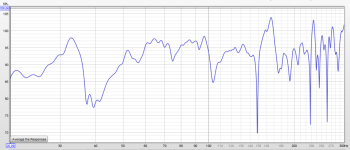
No, I cannot read the aligment. It's the 80l reflex box.
Here is the box simulator SPL graphs from all three above overlaid on the actual measurement, see correlation now? I cannot still 😀
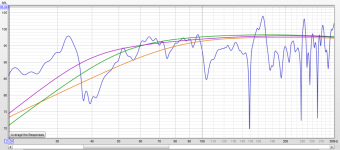
The green line is the corresponding simulation. Huge 14db peak above simulated SPL at 33Hz and 11db dip at 39Hz with the room and positioning I happened to have this time. I'd say the response would be pretty much the same regardless which one of the tree enclosures it was, a 113litre reflex box or 50litre closed box. They would have some differences, but none would measure like the simulation.
ps. the measurement voltage was not calibrated so the amplitudes are matched roughly by eye.
Alright, here is the 50l closed boxes, main speakers Left and Right and both overlaid. The boxes are at different location in room being Left and Right main speakers, while the mic stays put.
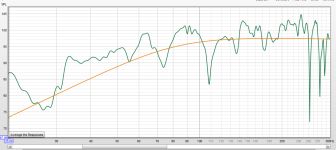
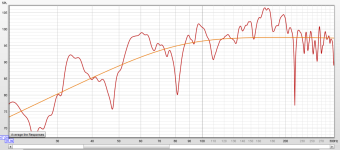
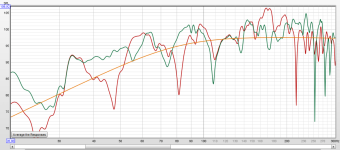
On these graphs the measured responses show trend of the simulated response quite nicely, varying roughly +/-10db due to influence of the room. I have to use EQ to make sound better like with all of the boxes. These small boxes sound lean without EQ and the bigger reflex boxes sound boomy without EQ, and with all of them it's very hard to get system bass nice sounding, which I attribute to peaks and dips in the response but of course could be anything as I'm a hobbyist.
Anyway, to get some feel on magnitude of things: If the room influence was translated into amplifier power it would mean that if I fed 10W to the speaker, the dips would be equivalent of feeding 1W power (10db less) and peaks 100W (10db more), total effect of room is 100x amplifier power! Looking at the combined graph, around 47Hz the left channel has 16db more output than the right, that is 40x difference in amplifier power between Left and Right channels, due to room.
So, manipulating positioning of things is very important, while box alignment is less important, almost meaningless in comparison at least in this particular example.
Lesson in my particular case presented here: as the room already ruins the bass response and manipulating it to liking would require separate bass system and EQ, or at least EQ, I could further ruin the bass without any extra harm by sacrificing some of the extra bass output that box simulators originally suggested, just tweak the EQ. This allowed to make smaller box that's both easier and cheaper to build, easier to accommodate and position in room, has less audible issues on midrange and bass performance is pretty much still the same as before, dominated by the room! I had to use EQ on all of the boxes to make system response balanced.
Based on this experience I don't mind main speaker bass alignment too much currently, other than better make it so that midrange works as well as possible, basically to optimize everything else than the bass. I feel main speaker bass box alignment has very little to do with perceived bass quality, instead one should consider utilizing separate bass system that is specifically adjusted with the room to get the response you want with SPL capability you want, by what ever means suit you like using some gradient bass system, positioning, EQ, multisub, tearing down the room, what ever.
Many of you already know all this, but many of you don't, like I didn't when starting off spending hours in front of WinISD looking at wrong things. It was interesting to see the graphs today, so though to share. Have fun!🙂
here some data to show magnitude of effects room has on bass response, and how much bass box alignment matters in comparison.
Short story: I've had some 15" woofers for many years and have been prototyping a speaker system with three way mains speaker equal amount of time. Currently on third bass box version for the mains, and I've been downsizing every time as I've always had to EQ the lows lows down to match up sensitivity of rest of the system. Also, I've felt there is coloration of sound from the bass box, which ought to reduce by better construct, smaller panels, modes inside higher up in frequency, minding about the port and so on. In general, as box gets smaller any issues get higher up in frequency, hopefully beyond pass band and out of harms way and should reduce any "box sound".
But that would compromise the bass, right, making box smaller than a simulator suggests? True if only looking anechoic response on the screen and forgetting the box will be in a room along with rest of the stereo playback system. And in this case, a 15" bass provides plenty enough for my home use, so there is extra SPL potential that can be sacrificed. Your system and context might differ, so please post if you have an example, perhaps even a counter example.
Anyway, my first box is already scrapped so approximating a bit. I remembered it was 150l but it was likely smaller as simulator suggests 113l for the driver automatically. Lets assume it was 113litre and try to remember the tuning. Second box was and still exists about 80l. Third box is sealed and only about 50l. Here are box simulator responses for the three, all using the same woofer:



Dramatic difference, right, the 50litre box response drops much higher than the other two and should have underwhelming bass. Also the 80litre box should shame on the 113litre, which should have much "better" bass, right, that's what the simulator automatically suggests at least.
Let's find out, here is measurement of one of the boxes. This is box that does sub woofer duty right now, and one of the three above. Mic was at listening spot, ungated sine sweep. Can you guess which one of the three is it? You can guess it reasoning with the text above, but the important bit is can you read the box alignment from this graph? The reflex boxes are tuned around 40Hz but here is crazy dip around 40Hz.

No, I cannot read the aligment. It's the 80l reflex box.
Here is the box simulator SPL graphs from all three above overlaid on the actual measurement, see correlation now? I cannot still 😀

The green line is the corresponding simulation. Huge 14db peak above simulated SPL at 33Hz and 11db dip at 39Hz with the room and positioning I happened to have this time. I'd say the response would be pretty much the same regardless which one of the tree enclosures it was, a 113litre reflex box or 50litre closed box. They would have some differences, but none would measure like the simulation.
ps. the measurement voltage was not calibrated so the amplitudes are matched roughly by eye.
Alright, here is the 50l closed boxes, main speakers Left and Right and both overlaid. The boxes are at different location in room being Left and Right main speakers, while the mic stays put.



On these graphs the measured responses show trend of the simulated response quite nicely, varying roughly +/-10db due to influence of the room. I have to use EQ to make sound better like with all of the boxes. These small boxes sound lean without EQ and the bigger reflex boxes sound boomy without EQ, and with all of them it's very hard to get system bass nice sounding, which I attribute to peaks and dips in the response but of course could be anything as I'm a hobbyist.
Anyway, to get some feel on magnitude of things: If the room influence was translated into amplifier power it would mean that if I fed 10W to the speaker, the dips would be equivalent of feeding 1W power (10db less) and peaks 100W (10db more), total effect of room is 100x amplifier power! Looking at the combined graph, around 47Hz the left channel has 16db more output than the right, that is 40x difference in amplifier power between Left and Right channels, due to room.
So, manipulating positioning of things is very important, while box alignment is less important, almost meaningless in comparison at least in this particular example.
Lesson in my particular case presented here: as the room already ruins the bass response and manipulating it to liking would require separate bass system and EQ, or at least EQ, I could further ruin the bass without any extra harm by sacrificing some of the extra bass output that box simulators originally suggested, just tweak the EQ. This allowed to make smaller box that's both easier and cheaper to build, easier to accommodate and position in room, has less audible issues on midrange and bass performance is pretty much still the same as before, dominated by the room! I had to use EQ on all of the boxes to make system response balanced.
Based on this experience I don't mind main speaker bass alignment too much currently, other than better make it so that midrange works as well as possible, basically to optimize everything else than the bass. I feel main speaker bass box alignment has very little to do with perceived bass quality, instead one should consider utilizing separate bass system that is specifically adjusted with the room to get the response you want with SPL capability you want, by what ever means suit you like using some gradient bass system, positioning, EQ, multisub, tearing down the room, what ever.
Many of you already know all this, but many of you don't, like I didn't when starting off spending hours in front of WinISD looking at wrong things. It was interesting to see the graphs today, so though to share. Have fun!🙂
Last edited:
Knowing it is one thing, wanting to accept quite another… thx for bringing insight one more time, don’t care if this all is known for more than 30 years in this field.
Thanks! It's fun to put stuff into graphs trying to come up with a set of graphs that would provide some insight as you say 🙂
As disclaimer I have to say I have no preference what would make good/best sounding bass in room. Any of these boxes had fine bass after adjusting the setup, so perhaps all there is to good bass quality is to be able to adjust the setup, and enough headroom in order to be able to do adjustment without too much limitations. Currently I have only one subwoofer and it's helping a little, need to play around with it more and also build few more to try multisub. Also need to experiment with dipole woofers at some point.
As disclaimer I have to say I have no preference what would make good/best sounding bass in room. Any of these boxes had fine bass after adjusting the setup, so perhaps all there is to good bass quality is to be able to adjust the setup, and enough headroom in order to be able to do adjustment without too much limitations. Currently I have only one subwoofer and it's helping a little, need to play around with it more and also build few more to try multisub. Also need to experiment with dipole woofers at some point.
What happens if you try playing with the damping factor?
It seems to me that in some rooms, there can be significant "two way communication" between the speaker and the room. Exactly why is still a bit unclear though.
A sceptical line of thinking is that the system is like 2 boxes with one membrane floating between them, except that the room suspension is magnitudes softer so it just shouldn't happen and whatever you "put into" the room via the speaker is what you get out, and whatever variation is solely due to the room itself. And the room can't influence the cone (or port pressure (really?)) to any appreciable degree.
However, if we think of a European-style room that is mostly solid brick or concrete, with a smallish exit area, that could have a fundamental Helmholz resonance and a series of overtones. So I suspect that the speaker could have a lot more leverage at some of those frequencies, than what would make sense with just echoes and boundary loading.
That's the only thing that makes sense, that would explain my observations where raising the output impedance can sometimes tame room modes. But I didn't have any good measurements to show.
It seems to me that in some rooms, there can be significant "two way communication" between the speaker and the room. Exactly why is still a bit unclear though.
A sceptical line of thinking is that the system is like 2 boxes with one membrane floating between them, except that the room suspension is magnitudes softer so it just shouldn't happen and whatever you "put into" the room via the speaker is what you get out, and whatever variation is solely due to the room itself. And the room can't influence the cone (or port pressure (really?)) to any appreciable degree.
However, if we think of a European-style room that is mostly solid brick or concrete, with a smallish exit area, that could have a fundamental Helmholz resonance and a series of overtones. So I suspect that the speaker could have a lot more leverage at some of those frequencies, than what would make sense with just echoes and boundary loading.
That's the only thing that makes sense, that would explain my observations where raising the output impedance can sometimes tame room modes. But I didn't have any good measurements to show.
Hi,
yeah there is likely many things at play simultaneously that all affect sound in room. A speaker with "two way communication" could affect some as well as a doorway as a port making some kind of resonator with the room volume. However, as it is sound pressure superimposing, the loudest sound dominates while quieter sounds make ripple to it. Thinking reflections only: in case of low frequency sounds with very long wavelengths multiple reflections are in similar phase and pile up making huge peaks and nulls appear, while on higher frequencies with shorter wavelengths the reflections and phases are more randomized and the net effect isn't as strong interference.
You could try to model a room as part of box with hornresp for example, or with some BEM software. WinISD accepts 50m^3 for box size and door as port and it shows tuning around 1Hz or so, which to me indicates that effect of a doorway would be minor in comparison to reflections from (all) walls, ceiling and floor.
Regarding a woofer working also as active sound absorber: if a 15" woofer emits sound, which then reflects off a wall and comes back say 10 meters later, surface area of the expanding wave would be enormous compared to the cone size and thus I would imagine the cone having very little effect to the sound in room, even if the woofer cone was perfect "cancellator" sucking out sound in the room it would do so only very small portion of the expanding wave. You could research how room acoustic treatment for the very low frequencies work, I'm no too familiar with them but I have a hunch they must be quite big in order to be effective, like square meter big, much bigger than a woofer cone or woofer box. On the other hand, you could use the woofer emit another sound wave superimposing suitably somewhere in the room, but again the cancellation would not be effective everywhere as it would be small sound source just starting to expand against multiple huge (almost) plane waves coming from all directions, and thus count effects minor again. You might be able to use the minor effects localized to a specific point, like at listening spot though.
As you can see I'm not an expert on this, using imagination to figure out how it might play out, and what could be relatively effective and what not.
Anyway, for these reasons I think that the woofer or doorway likely have some effect on room response, but they would be minor compared to all "reflections" combining and piling up together making very strong interference pattern. How minor, or significant, I have no idea. Total effect of room is very significant, much more so than effect of box alignment for example.
yeah there is likely many things at play simultaneously that all affect sound in room. A speaker with "two way communication" could affect some as well as a doorway as a port making some kind of resonator with the room volume. However, as it is sound pressure superimposing, the loudest sound dominates while quieter sounds make ripple to it. Thinking reflections only: in case of low frequency sounds with very long wavelengths multiple reflections are in similar phase and pile up making huge peaks and nulls appear, while on higher frequencies with shorter wavelengths the reflections and phases are more randomized and the net effect isn't as strong interference.
You could try to model a room as part of box with hornresp for example, or with some BEM software. WinISD accepts 50m^3 for box size and door as port and it shows tuning around 1Hz or so, which to me indicates that effect of a doorway would be minor in comparison to reflections from (all) walls, ceiling and floor.
Regarding a woofer working also as active sound absorber: if a 15" woofer emits sound, which then reflects off a wall and comes back say 10 meters later, surface area of the expanding wave would be enormous compared to the cone size and thus I would imagine the cone having very little effect to the sound in room, even if the woofer cone was perfect "cancellator" sucking out sound in the room it would do so only very small portion of the expanding wave. You could research how room acoustic treatment for the very low frequencies work, I'm no too familiar with them but I have a hunch they must be quite big in order to be effective, like square meter big, much bigger than a woofer cone or woofer box. On the other hand, you could use the woofer emit another sound wave superimposing suitably somewhere in the room, but again the cancellation would not be effective everywhere as it would be small sound source just starting to expand against multiple huge (almost) plane waves coming from all directions, and thus count effects minor again. You might be able to use the minor effects localized to a specific point, like at listening spot though.
As you can see I'm not an expert on this, using imagination to figure out how it might play out, and what could be relatively effective and what not.
Anyway, for these reasons I think that the woofer or doorway likely have some effect on room response, but they would be minor compared to all "reflections" combining and piling up together making very strong interference pattern. How minor, or significant, I have no idea. Total effect of room is very significant, much more so than effect of box alignment for example.
There are quite a few well documented ways to set up multiple subwoofers in an arrangement, that works as a form of active room treatment. The Welti midwall arrangements are good for reducing spacial variance, making the response more even across a larger area of space. They can also be used in a source sink arrangement by delaying the rear source and reducing amplitude in a similar way to DBA's or CABS setups where there is an attempt to set up a plane wave which can cancel modes in that direction.Regarding a woofer working also as active sound absorber: if a 15" woofer emits sound, which then reflects off a wall and comes back say 10 meters later, surface area of the expanding wave would be enormous compared to the cone size and thus I would imagine the cone having very little effect to the sound in room, even if the woofer cone was perfect "cancellator" sucking out sound in the room it would do so only very small portion of the expanding wave. You could research how room acoustic treatment for the very low frequencies work, I'm no too familiar with them but I have a hunch they must be quite big in order to be effective, like square meter big, much bigger than a woofer cone or woofer box. On the other hand, you could use the woofer emit another sound wave superimposing suitably somewhere in the room, but again the cancellation would not be effective everywhere as it would be small sound source just starting to expand against multiple huge (almost) plane waves coming from all directions, and thus count effects minor again. You might be able to use the minor effects localized to a specific point, like at listening spot though.
Papers from Fazenda attached. Even simple source sink arrangements can reduce the low frequency decay below the threshold where it can be detected. Much effort has been put into making the frequency response flat, but it does seem that perhaps that effort should be put into reducing decay times.
Also a translated version of Follgott's simulations of different woofer setups.
Attachments
Hi,
thanks for the resources!
Yeah there is plenty of ways to try and tackle the room response, basically some sort of bass system that is tuned to the room, in situ. I haven't tried multisubs or even proper single sub doing double duty as sink as I believe it needs FIR capability and not having it handy, so been experimenting just with delays, positioning and IIR EQ.
The double bass array seems elegant, except it is not practical for living room usage and perhaps quite expensive. On the other hand it seems a good solution, tearing down walls without actually doing it. There is some concern with it as well, even if the sub system worked as intended what about the mains, how to handle the transition? Also it would be a mono solution as it is usually presented source on front and sink on the back. Perhaps could be stereo if it was installed on sidewalls and done both ways. Similar problems with any solution so perhaps it's not too relevant concern, just try out and find out what one likes better for some reasons.
Also, if looking at psychoacoustic smoothing with the graphs (from first post) the responses are much nicer:
(levels adjusted from the first post, to line up the sims to measurements better)
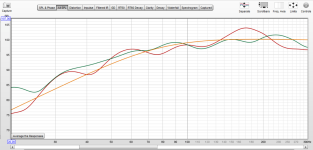
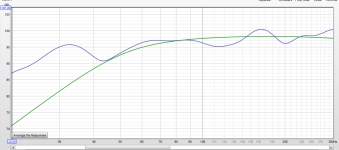
So, as you say active solution could be used in many ways, and could be setup in multiple ways like DBA or just multisub distributed all around, which all could work fine looking at various graphs, but perhaps still could have difference in perceived sound. For example how attacks are perceived. At least this is what I've noted from the forums, but haven't tested myself so not sure what to prefer or is it all fine. Need to read the papers you've posted.
thanks for the resources!
Yeah there is plenty of ways to try and tackle the room response, basically some sort of bass system that is tuned to the room, in situ. I haven't tried multisubs or even proper single sub doing double duty as sink as I believe it needs FIR capability and not having it handy, so been experimenting just with delays, positioning and IIR EQ.
The double bass array seems elegant, except it is not practical for living room usage and perhaps quite expensive. On the other hand it seems a good solution, tearing down walls without actually doing it. There is some concern with it as well, even if the sub system worked as intended what about the mains, how to handle the transition? Also it would be a mono solution as it is usually presented source on front and sink on the back. Perhaps could be stereo if it was installed on sidewalls and done both ways. Similar problems with any solution so perhaps it's not too relevant concern, just try out and find out what one likes better for some reasons.
Also, if looking at psychoacoustic smoothing with the graphs (from first post) the responses are much nicer:
(levels adjusted from the first post, to line up the sims to measurements better)


So, as you say active solution could be used in many ways, and could be setup in multiple ways like DBA or just multisub distributed all around, which all could work fine looking at various graphs, but perhaps still could have difference in perceived sound. For example how attacks are perceived. At least this is what I've noted from the forums, but haven't tested myself so not sure what to prefer or is it all fine. Need to read the papers you've posted.
Last edited:
Have a good look at Follgott's simulations, there are quite a few variations including some stereo ones. In the Fazenda study the best scoring was a single source and sink setup, so one sub on the front wall, one on the back wall. Most things work better for rectangular rooms, if there is no back wall in a very open plan situation it might not work, but in most others it will at least reduce the low frequency decay which is normally hard to do. If you have two spare woofers it would be worth a try.
Also look at the decay times in REW with the different measurements you have.
Also look at the decay times in REW with the different measurements you have.
Thanks, and that would make a counter example: box alignment of main speaker boxes would matter if two spare woofers on the back wall was used to form a bass system together with the mains, as long as it would reduce effects of room.
I could speculate back woofers would benefit having about the same box alignment as mains speakers have. At least for convenience if nothing else, also opportunity to try and improve construction / finish of the main woofers. Hmm, perhaps project is to build some new boxes for main woofers and use the old ones as subs on the back 🙂
I could speculate back woofers would benefit having about the same box alignment as mains speakers have. At least for convenience if nothing else, also opportunity to try and improve construction / finish of the main woofers. Hmm, perhaps project is to build some new boxes for main woofers and use the old ones as subs on the back 🙂
The EQ method I used a couple of years ago was with parametric EQ using Calf plugin pack for JACK on a Linux machine, and homing in on the most obtrusive resonances with a music keyboard. Kind-of flying blind but I discovered that fixing just 2 or 3 of the biggest resonances (in order of subjective importance) made a huge improvement. And with 2 or maybe 3 notches, the complexity is low enough to make analogue filters.
^This can only work at a given point in space in a room. If you move around or have a wide sweetspot it doesn't work. Only multisub or DBA (or variant) can work over wide area.
Remind me of P.A. engineer which applied this kind of recipe: worked for the place where the desk was located but no more bass in spots in front of the stage... it was better without this kind of treatments overall.
Remind me of P.A. engineer which applied this kind of recipe: worked for the place where the desk was located but no more bass in spots in front of the stage... it was better without this kind of treatments overall.
The lowest (and biggest) resonance was about 40Hz, so a wavelength of ~8.5m gave some of freedom of movement. And if my suspicion was accurate that Helmholz resonances were the cause, we could be dealing with lobes (or whatever they should be called) of pressure, with no regions of cancellation as such, just phase lag.
That's not to say that cancellation and summation from echoes won't play a part, just that in my case the 'booming' character of individual notes was the noticeable factor, and that was fixed by carefully matching the Q of the resonance with the Q of the notch filter. Very fiddly to do by hand, but doable.
That's not to say that cancellation and summation from echoes won't play a part, just that in my case the 'booming' character of individual notes was the noticeable factor, and that was fixed by carefully matching the Q of the resonance with the Q of the notch filter. Very fiddly to do by hand, but doable.
Sorry but you don't get what a room mode is, or at least how it is identified by science and dedicated field about it ( room acoustic). There is no such things as helmotz resonator involved, no lobes either.
Room modes are... room modes. It's a relationship of dimension relative to wavelength and location of exiting source and point of observation... with pressure zone and depression zone ( with zone with 'correct' pressure zone in between).
Only phase lag? Have you ever walked through your room while playing a droning low freq? You should as it is easy to spot the pressure zone and the cancelation's one by ear... no phase lag in this at least this is not what you would notice at first in a domestic room.
Distribution in space is most of the time very specific especially for very low freq ( in pro world we are used to 'room map'* representation where you can locate them - by frequency- very easily). The built techniques used for the room can influence results ( leaky construction vs concrete shell will give different rendering, shell being 'worst' if not used with dedicated strategy...) as well as room shape ( a cube being the worst, complex shape can help to locate modes outside of listening position which can be a valid strategy to not be bothered by them...).
But overall it's relatively easy (and accurate) to simulate. Even better to measure them by yourself**.
From there you'll quickly see your recipe can only work on one and only place.
*it was something exclusive to pricey dedicated acoustic simulation software for many years. Not anymore with something like 'roommap' plugin, you can use with Rew and a mic to identify and make a map of your own room.
** here is an example of how to do it. It's in french but google direct translation should work at least in english ( 'CC' box on right upper corner) anf it talk by itself with pictures anyway...
Tmuikku,
What was your target for final Qtc of room+box behavior? I hear difference between 0.577 and 0.707 for example with sealed. And i think i can hear overshoot behavior even if the room is supposed to mess it up.
Room modes are... room modes. It's a relationship of dimension relative to wavelength and location of exiting source and point of observation... with pressure zone and depression zone ( with zone with 'correct' pressure zone in between).
Only phase lag? Have you ever walked through your room while playing a droning low freq? You should as it is easy to spot the pressure zone and the cancelation's one by ear... no phase lag in this at least this is not what you would notice at first in a domestic room.
Distribution in space is most of the time very specific especially for very low freq ( in pro world we are used to 'room map'* representation where you can locate them - by frequency- very easily). The built techniques used for the room can influence results ( leaky construction vs concrete shell will give different rendering, shell being 'worst' if not used with dedicated strategy...) as well as room shape ( a cube being the worst, complex shape can help to locate modes outside of listening position which can be a valid strategy to not be bothered by them...).
But overall it's relatively easy (and accurate) to simulate. Even better to measure them by yourself**.
From there you'll quickly see your recipe can only work on one and only place.
*it was something exclusive to pricey dedicated acoustic simulation software for many years. Not anymore with something like 'roommap' plugin, you can use with Rew and a mic to identify and make a map of your own room.
** here is an example of how to do it. It's in french but google direct translation should work at least in english ( 'CC' box on right upper corner) anf it talk by itself with pictures anyway...
Tmuikku,
What was your target for final Qtc of room+box behavior? I hear difference between 0.577 and 0.707 for example with sealed. And i think i can hear overshoot behavior even if the room is supposed to mess it up.
I find 0.577 more real or true. It's difficult to express by words but with 'real' (acoustic) instruments i find it closer to real life sound ( i can often compare to real instruments including double bass).
As i'm lucky to have easy access to outdoor i heard the lack of overshoot 0,577 qtc have too vs other qtc like 0,707 or 1 or more and i think i can identify it too in a room but i've not performed any abx about it so i maybe fool myself with this.
That said i listen mostly below or at critical distance with time aligned system so it might play a role too?
As i'm lucky to have easy access to outdoor i heard the lack of overshoot 0,577 qtc have too vs other qtc like 0,707 or 1 or more and i think i can identify it too in a room but i've not performed any abx about it so i maybe fool myself with this.
That said i listen mostly below or at critical distance with time aligned system so it might play a role too?
Hi,Tmuikku,
What was your target for final Qtc of room+box behavior? I hear difference between 0.577 and 0.707 for example with sealed. And i think i can hear overshoot behavior even if the room is supposed to mess it up.
I haven't thought about it, as bass has been a mess in general. In other words the droning, or response changing constantly, draws the attention and is the main issue. I need to calculate how big ~0.5Q box would be, I think these main speakers are about 0.7, perhaps bit over. It would be fun test to try and listen.
I hope you do hear a difference, otherwise it wouldn't be very important metric 🙂 Sub is ported atm, so system Q is something else, ad if room is included I'm not sure how to come up with a value 🙂
No need to apologize. I could never be scientific in these sort of matters -- I ask too many questions! Like what was the size of the room?Sorry but you don't get what a room mode is, or at least how it is identified by science and dedicated field about it ( room acoustic).
Here is audibility thresholds from Fazenda study:There are quite a few well documented ways to set up multiple subwoofers in an arrangement, that works as a form of active room treatment. The Welti midwall arrangements are good for reducing spacial variance, making the response more even across a larger area of space. They can also be used in a source sink arrangement by delaying the rear source and reducing amplitude in a similar way to DBA's or CABS setups where there is an attempt to set up a plane wave which can cancel modes in that direction.
Papers from Fazenda attached. Even simple source sink arrangements can reduce the low frequency decay below the threshold where it can be detected. Much effort has been put into making the frequency response flat, but it does seem that perhaps that effort should be put into reducing decay times.
Also a translated version of Follgott's simulations of different woofer setups.
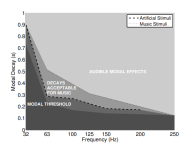
And as you say, on the other paper it looks like CABS or "Source-to-Sink" could work nicely reducing decay times while being relatively practical solution as well.
Looking my REW files trying to align subwoofer that is on my left, and not on the back of the room, about every "alignment" attempt I checked seem to have led to longer decay times than any effort at all. Also, tried on few measurements that EQ had very little if any effect on decay times.
Until now I have tried to achieve relatively smooth SPL graphs first adjusting delay and polarity avoiding EQ, as that has felt intuitive way to align the stuff. Also REW offers decay window with EQ tool and SPL window with aligment tool, which supports the intuition. But, that seems opposite how it should be done:
reasoning from the Fazenda studies and quick look on the REW measurements, the positioning and delay / phase of sub(s) could and should be used to control decay times, while EQ could be used seemingly independently after that, knock down peaks if bad and do any voicing. With bad peak I mean such peak that seems to appear on quite big area at the listening spot and takes the attention.
Is there way to change alignment tool to show waterfall / decay times in REW, or how to achieve similar functionality as with the alignment tool seeing decay times in realtime?
Gotta move the sub to the backwall try it out.
Last edited:
Simulations I have made in AKABAK gave the best result when the delay time was adjusted to be a little bit more than the delay due to the room length from calculation. Reducing the rear sub helped a little bit, though that parameter seemed quite insensitive in AKABAK. I was looking for a practical benefit with a simple setup so I put the subs on the floor for a start. Arrangement 5.2 from Nils document is something I might try too as it would also work in my new room.
I don't think there is way to see the decay change in realtime in REW, at least I don't know how if it can.
EQ can help at the peak frequency but in the Fazenda paper it states that the decay then often gets worse at some other frequency. Getting the source and sink subs to work together does do quite a lot for frequency response smoothness too, in that at least below 100Hz there tends to be less deep nulls.


I don't think there is way to see the decay change in realtime in REW, at least I don't know how if it can.
EQ can help at the peak frequency but in the Fazenda paper it states that the decay then often gets worse at some other frequency. Getting the source and sink subs to work together does do quite a lot for frequency response smoothness too, in that at least below 100Hz there tends to be less deep nulls.
- Home
- Loudspeakers
- Multi-Way
- Bass response in room, box simulation compared to measured response